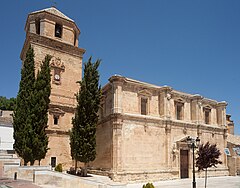Huelma
| Huelma municipality | ||
|---|---|---|
 Huelma - town view with castle and church
|
||
| coat of arms | Map of Spain | |

|
|
|
| Basic data | ||
| Autonomous Community : |
|
|
| Province : | Jaén | |
| Comarca : | Sierra Mágina (Comarca) | |
| Coordinates | 37 ° 39 ′ N , 3 ° 27 ′ W | |
| Height : | 950 msnm | |
| Area : | 250.29 km² | |
| Residents : | 5,776 (Jan 1, 2019) | |
| Population density : | 23.08 inhabitants / km² | |
| Postal code : | 23560 | |
| Municipality number ( INE ): | 23044 | |
| administration | ||
| Website : | Huelma | |
Huelma is a small town in southern Spain and a municipality ( municipio ) consisting of the main town and the village of Solera with a total of 5,776 inhabitants (as of January 1, 2019) in the south of the province of Jaén in the autonomous region of Andalusia . The old town center is recognized as a cultural asset ( Bien de Interés Cultural ) in the Conjunto histórico-artístico category .
Toponym
The place name is of Arabic-Moorish origin and means something like "source".
location
The place Huelma is located at the foot of a strategically advantageous hill about 50 km (driving distance) southeast of the provincial capital Jaén at an altitude of about 950 m. The climate in winter is moderate, in summer it is warm to hot; the low amounts of precipitation (approx. 545 mm / year) fall - with the exception of the almost rainless summer months - distributed over the whole year.
Population development
| year | 1857 | 1900 | 1950 | 2000 | 2017 |
| Residents | 3,355 | 4,649 | 8,556 | 6.232 | 5,932 |
The significant population decline in the second half of the 20th century is mainly due to the large-scale planting of olive trees, the associated mechanization and the resulting loss of jobs.
economy
Huelma lies in the middle of the endless olive tree plantations of the province of Jaén. But grain, grapevines, etc. are also planted for self-sufficiency ; Vegetables came from the house gardens. Small traders, craftsmen and service companies of all kinds have settled in the village. A nationally important agricultural show takes place once a year in Huelma (ExpoHuelma) .
history
Finds in the municipality indicate a settlement by Iberian tribal groups in the 5th or 4th century BC. Close. Since the 8th century, the place, which at that time already existed, was under Moorish rule. It was not until 1438 that Huelma was recaptured ( reconquista ) by Iñigo López de Mendoza , the Marqués de Santillana, on behalf of King John II of Castile . In 1464 Henry IV named his favorite Beltrán de la Cueva (1435-1492) the first " Duke of Alburquerque " and ten years later the "Count of Huelma". After his death, the place and its castle fell to his first-born son Francisco I. Fernández de la Cueva y Mendoza (1467–1526), who is responsible for the new construction of the castle. In 1975 the place Solera was incorporated.
Attractions
- The castle (castillo) was not built until the beginning of the 16th century by order of the local landlord (señor) , the Duke of Alburquerque , on a natural rock instead of an older Moorish fortress. The core structure, surrounded by three-quarter-round corner towers, measures only approx. 14 × 11.50 m, but these dimensions go well beyond those of an older keep (torre del homenaje) . Several small windows break through the outer walls.
- The remains of the medieval city wall (muralla) and that of an aqueduct are of little interest.
- The Iglesia de la Inmaculata Concepción is dedicated to the Immaculate Conception of Mary . Construction began in 1559 on the site of a previous building; however, the bell tower (campanario) was not completed until 1616. The portal is on the south side of the three-aisled hall church ; its supports are designed as bundle pillars and support the vault , which consists of various Gothic and Renaissance elements. Several architects were involved in the construction of the church - including Diego de Siloé , Andrés de Vandelvira and Francisco del Castillo El Mozo.
- Surroundings
- The village of Solera , located about 10 km to the northeast, stretches picturesquely along a 1120 m high mountain saddle.
- The Parque natural Sierra Mágina surrounding the city is ideal for hiking.
literature
- Rafael López Guzmán: Huelma, Iglesia parroquial. Huelma 1982, ISBN 978-84-50078-59-6
- Rafael López Guzmán: Huelma, arte y cultura. Granada 2009, ISBN 978-84-96101-80-7 .
Web links
Individual evidence
- ↑ Cifras oficiales de población resultantes de la revisión del Padrón municipal a 1 de enero . Population statistics from the Instituto Nacional de Estadística (population update).
- ↑ Huelma - climate tables
- ↑ Huelma - population development
- ^ Huelma - Castillo
- ↑ Huelma - city wall
- ↑ Huelma - Aqueduct
- ↑ Huelma Church
- ↑ Huelma Church

